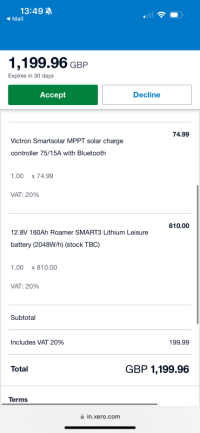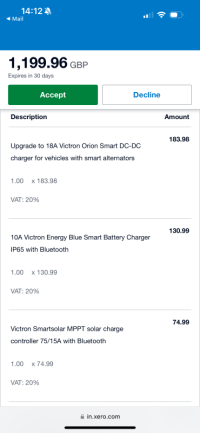I’ve done thisAlso worth posting a picture of your starter battery under the bonnet so people can see if anything has been connected to the negative terminal by the convertor, if so this would be wrong for a stop start smart alternator
Thank you very much.I’m a bit confused about your description I’m afraid.
To confirm - the ‘alternator’ is what charges the starter battery (and therefore powers the normal vehicle electrics) when the engine is running. It’s a standard part of the van. Is that what you are meaning?
You mention a ‘fuse in the back’ that you turn on when on mains. That’s not what a fuse is used for. Can you highlight it on a pic?
I have a hunch that your inverter may be attached direct to your starter battery via the thick black lead with a red end that goes from the + terminal of the starter battery. It looks similar to the one going to the back of the inverter on one of the pics. If that’s the case you will flatten the starter battery very quickly - possibly hence the low voltage warnings you are getting. It needs to go to the leisure battery. I guess the red lead goes to the DS300. Both should (must) have a fuse very close to the starter battery - possibly just off the left of your pic above.
The two standard 3 pin plugs under the control panel will almost certainly only work when on mains hookup (and you’ve turned the ‘fuse’ on). I’m not familiar with your control panel so you may need to make a selection there too (instructions will be online - try 12voltplanet). It’s theoretically possible to make those sockets work from the inverter but I doubt that is how they’ve been wired given the rest of the setup.
The USB and cig lighter sockets above will be powered from your leisure battery via the control panel.
I suggest you ensure the inverter is turned off and all other sockets, lights etc. Connect to hookup and ensure the mains charger (Rayne) is charging - leave it for a good 12 hours until the little indicator light has gone to the end of the cycle. That will ensure your leisure battery is as charged as much as it can be. If wired correctly it will also top up the starter battery. At least the you know the batteries are charged and can work from there. Good luck!
This is exactly how everything works. Apologies, I’ve confused things by using the wrong word. I meant inverter and not alternator!
What I mean is though… when I am off grin, not hooked up to mains… I was told, if I then turn on the inverter… it will allow me to use the two plug sockets on the inverter and I can use these when off grid for things such as plugging in my laptop.
But when I turn the inverter on… and plug something in… it doesn’t work.
Why would that be?

 Got it. Possibly because whichever battery it’s connected to hasn’t got enough power. The light may come on but not enough power to produce 240v. Get both batteries fully charged and see if it works. Whatever the outcome the inverter needs to be powered by the leisure battery rather than the starter battery otherwise you will end up stranding yourself.
Got it. Possibly because whichever battery it’s connected to hasn’t got enough power. The light may come on but not enough power to produce 240v. Get both batteries fully charged and see if it works. Whatever the outcome the inverter needs to be powered by the leisure battery rather than the starter battery otherwise you will end up stranding yourself.

